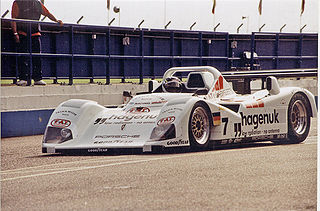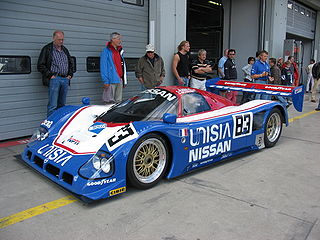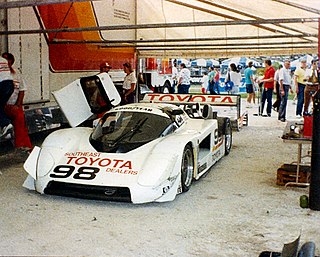

The Toyota 87C, also known as the TOM'S 87C, was a Group C prototype sports car, designed, developed and built by Toyota, for use in sports car racing, specifically the World Sportscar Championship, between 1987 and 1988. [1] [2] [3] [4]


The Toyota 87C, also known as the TOM'S 87C, was a Group C prototype sports car, designed, developed and built by Toyota, for use in sports car racing, specifically the World Sportscar Championship, between 1987 and 1988. [1] [2] [3] [4]
In the winter of 1986/1987, those responsible for motorsport at Toyota decided to step up their commitment to the sports car world championship. First and foremost, this meant more money for the development and use of racing cars. With the start of Group C in 1982, Toyota got involved in sports car racing. However, the vehicles have not yet been built or used by Toyota. The development and construction of the racing cars were in the hands of the technicians at Dome, a company founded in 1978 by Minoru Hayashi that specialized in building racing cars. For example, the previous model of the 87C was officially called the Dome 86C.
TOM'S Co. Ltd. took over the races. - Tachi Iowa Motor Sport - is named after the two founders Nobuhide Tachi and Kiyoshi Iowa. The racing team, founded in 1974, took care of the logistics of the operations, while Toyota was partly responsible for operational planning. This variant of team leadership is not uncommon among manufacturers in sports car racing. The connection between Audi and Joest Racing may serve as an example from the present.
The main innovation in technology was the engine. The previous 4-cylinder 4T GT engine, which was based on mass production, was retired. The new 2.1-liter 4-cylinder turbocharged engine was given a completely new engine management system and delivered 620 hp (460 kW). After the first test drives, the wall thickness of the engine block was increased, which made the unit heavier but also more durable.
The racing car designer Masahiro Ohkuni moved from Dome to the group and developed three aluminum chassis together with Dome technicians. The cars looked very successful and compact. However, the 87C lacked sufficient downforce from the start; the main reason why the cars were too slow on the fast Le Mans circuit. In 1987 Toyota was almost exclusively interested in the 24 Hours of Le Mans, where overall victory has been the big goal since entering sports car racing. However, this focus on one race was a certain developmental disadvantage compared to the competition. Although the vehicles were registered for a few races before Le Mans, the car and the team were missing racing kilometers, which also served to eliminate weaknesses in aerodynamics and tuning.
Two chassis were used by TOM'S; Chassis 001 was taken over by Dome and entered there as Dome 87C for a total of six races.
The 87C made its racing debut at the Suzuka 500 km race. The race was the first race event of the All Japan Sports Prototype Championship that year. No compromises were made with the drivers and the cockpits were entrusted to experienced pilots. In the 87C with starting #36 sat the Formula One World Champion of the 1980 Formula One season, the Australian Alan Jones, who was able to sign up after a failed Formula 1 comeback. His partner was veteran long-distance pilot Geoff Lees. After finishing fifth in practice, the duo finished third overall, on the same lap as the winners Hideki Okada and Mike Thackwell in a Porsche 962C and another Porsche driven by Kunimitsu Takahashi and Kenny Acheson. In the second race, the Japanese championship round in Fuji, there was a surprising overall victory for Jones, Lees, and Masanori Sekiya. [5]
After a sobering Le Mans test weekend in May 1987, where the fastest car, Raul Boesel's Jaguar XJR-8, missed a lap by almost 10 seconds, the TOM'S racing team came to the actual race in June with two cars. The car with the number 37 was driven by the two Japanese Masanori Sekiya and Kaoru Hoshino and the Englishman Tiff Needell. Alan Jones, Geoff Lees, and Dome works driver Eje Elghthe prototype with the number 36. The operation turned into a disaster. Alan Jones was left on the track after 19 laps without fuel because the team miscalculated the amount of fuel after the second pit stop. The sister car drove only twenty laps longer, then the drive ended with an engine failure. [6]
The racing type was far more successful in the Japanese sports car championship than in Le Mans. Lees, Sekiya and Hitoshi Ogawa won the Suzuka 1000 km. The 87C was last used at the factory in the 1000 km race at Fuji, the last race of the sports car world championship in 1987. [7]
At the end of the year a chassis was sold to a private team and introduced as the new works car, the 88C.

Johannes Antonius "Jan" Lammers is a Dutch racecar driver, most notable for winning the 1988 24 Hours of Le Mans world endurance race, for Silk Cut Jaguar/TWR; after four seasons in Formula One racing, from 1979 through 1982, for the F1 teams of Shadow, ATS, Ensign and Theodore, respectively. After a world-record setting ten-year hiatus, Lammers made a brief Formula One comeback, for two races, with team March in 1992. Aside from racing in these two of the highest leagues of global auto-sports, Lammers has raced in an exceptionally wide number of racing series and competitions, domestic and abroad, over four decades.

The 1993 24 Hours of Le Mans was the 61st Grand Prix of Endurance, and took place on 19 and 20 June 1993.

The 1992 24 Hours of Le Mans was the 60th Grand Prix of Endurance, taking place at the Circuit de la Sarthe, France, on the 20 and 21 June 1992. It was also the third round of the 1992 FIA Sportscar World Championship season. The FIA was struggling to assemble sufficient cars for the race, and so the entry-list was extended to include the older Group C cars and national trophy cars. The 28 starters was the lowest since the 1932 race. With the withdrawal of the Jaguar and Mercedes-Benz teams, it looked to be a Peugeot vs Toyota contest, each with very strong driver combinations, with the new Mazdas there waiting for any slip-ups. There were still considerable concerns that the 3.5-litre engines derived from Formula 1 could not last the distance. It was Philippe Alliot who took pole position for Peugeot, in a blistering lap fully five seconds faster than the lap record, with teammate Dalmas second.

The 1990 24 Hours of Le Mans was the 58th Grand Prix of Endurance, taking place at the Circuit de la Sarthe, France, on the 16 and 17 June 1990. Due to the ongoing dispute between the ACO and the FISA governing body, the race was not part of the World Sports-Prototype Championship. This was the last Le Mans run under the Group C formula, and a number of manufacturers put in a major effort to win, with the notable exception of defending winners Sauber-Mercedes.

The 1989 24 Hours of Le Mans was the 57th Grand Prix of Endurance, taking place at the Circuit de la Sarthe, France, on the 10 and 11 June 1989. This year it was not included as a round of the 1989 World Sports-Prototype Championship. The entry list promised a strong contest between five manufacturers. Jaguar had won in 1988 and went on to win the championship; while Sauber had finished second and was now matching Jaguar on the track. New regulations were coming in 1991, and the first examples of the 3.5-litre normally-aspirated formula were entered by Spice Engineering.

The Toyota TS010 was a Group C racing car built by Toyota for the Sportscar World Championship, All Japan Sports Prototype Championship, and the 24 Hours of Le Mans.

The 1988 24 Hours of Le Mans was the 56th Grand Prix of Endurance as well as the fifth round of the 1988 World Sports-Prototype Championship. It took place at the Circuit de la Sarthe, France, on the 11 and 12 June 1988. At their third attempt, Jaguar arrived with five cars to take on the strong Porsche works team of three cars, in their only race for the Championship season. The other potential rival was Sauber, now formally backed by Mercedes-Benz, but after a major high-speed tyre-blowout in practice, their two-car team was withdrawn.

The 1987 24 Hours of Le Mans was the 55th Grand Prix of Endurance as well as the fifth round of the 1987 World Sports-Prototype Championship. It took place at the Circuit de la Sarthe, France, on the 13 and 14 June 1987. Jaguar was a strong contender, have won the four preceding rounds of the Championship. The Porsche works team had installed a new 3-litre engine into their 962s but their turbo engines would test their fuel economy.

The 1986 24 Hours of Le Mans was the 54th Grand Prix of Endurance as well as the third round of the 1986 World Sports-Prototype Championship. It took place at the Circuit de la Sarthe, France, on 31 May and 1 June 1986. This year saw the return of a full Jaguar works team, to take on the strong Porsche works and customer teams. However, with the fuel regulations relaxed, the turbo-charged cars would be able to use more of their potential power to outrun the normally-aspirated 6-litre Jaguars.

Dome Co. Ltd, literally "child's dream", is a Japanese racing car constructor involved mainly in open-wheel and sports car racing.
Masanori Sekiya is a Japanese former racing driver, most famous for being the first Japanese driver to win the 24 Hours of Le Mans, in 1995.

The Porsche WSC-95 was a Le Mans Prototype originally built by Tom Walkinshaw Racing. It was modified by Porsche from the original Group C Jaguar XJR-14 from which it derived, and run by Joest Racing. Originally intended to race in the IMSA World Sportscar Championship, the WSC-95 saw very little race action even though it won the 24 Hours of Le Mans in both 1996 and 1997 without being acknowledged as a factory supported project. It was later upgraded to the Porsche LMP1-98 before being retired. Only two cars were ever built.

The Nissan R90C was a platform used for Group C racing cars built in 1990 by Nissan Motors for competition in World Sportscar Championship (WSC) based in Europe and the All Japan Sports Prototype Championship (JSPC). The cars based on the basic R90C platform would compete until 1993 before Nissan chose to withdraw from sports car racing, not returning until 1997. It won three JSPC championships and several significant endurance races during its career.

The Sard MC8-R was a modified and lengthened version of the Toyota MR2 (SW20) built for GT racing by Toyota's SARD works team.

The Toyota 88C was a racing car entered by Toyota from 1988 to 1989. It is the successor to the Toyota 87C and the predecessor to the Toyota 88C-V. Like other Toyota-powered sports prototypes of the era, it was designed and built by Dome. The 88C is an evolution of the 87C, both models sharing the same chassis number designation. The 88Cs competed in the All Japan Sports Prototype Championship, the World Sports-Prototype Championship, and the North American Camel GT Championship.
Lars Eje Elgh is a Swedish racing driver and television reporter. He currently works as an expert commentator for Formula One in Sweden together with Janne Blomqvist. The two have worked together as Formula One commentators for a long time, first for TV4 and then for Viasat Motor when they took over the Formula One broadcasting in Sweden.

The Sugo Inter 500 km, was the fifth round of both the 1991 All Japan Sports Prototype Championship and the 1991 Long Distance Series, held at the Sugo on 15 September, in front of a crowd of approximately 45,000.
The Dome RC83 was a Group C sports racing car built by Dome in 1983. A replacement for the RC82, which had been unsuccessful in its two 1982 entries, the car featured a 4-litre Cosworth DFL V8 engine and was developed in-house, unlike the RC82, which had a March Engineering chassis. One car was built. The car was replaced by the Dome 84C partway through the 1984 season, although the two cars did overlap during that year.

The Suzuka 500 km, was the opening round of the 1987 All Japan Sports Prototype Championship was held at the Suzuka Circuit, on 12 April, in front of a crowd of approximately 18,000.
Tetsu Ikuzawa is a Japanese former racing driver, team executive, and businessman from Tokyo, Japan. He is one of the most successful and prolific Japanese drivers from the early years of the nation's automobile racing history. Ikuzawa was the first Japanese driver to regularly compete in a number of notable European championships, namely the British Formula Three Championship and European Formula Two Championship. He was also one of the first Japanese drivers to compete in the 24 Hours of Le Mans endurance race, making his first start in 1973 for Sigma Automotive alongside his countryman, Hiroshi Fushida. In domestic competition, Ikuzawa won the 1964 and 1967 Japanese Grand Prix sports car races, and the 1977 Fuji Grand Champion Series.